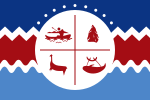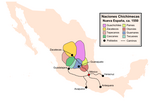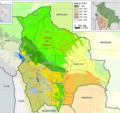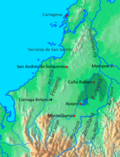Timoto–Cuica people were an Indigenous people of the Americas composed primarily of two large tribes, the Timote and the Cuica, that inhabited in the Andes...
6 KB (518 words) - 04:57, 24 May 2024
region of western Venezuela, complex Andean civilization of the Timoto-Cuica people flourished before European contact. After the first contacts between...
82 KB (9,934 words) - 15:35, 15 August 2024
ethanol and coca leaves during the time before their deaths. The Timoto–Cuica people worshiped idols of stone and clay, built temples, and offered human...
20 KB (2,369 words) - 03:27, 30 May 2024
languages, each a pair of dialects: Timote–Cuica (Miguri, Cuica, "Cicua", spoken by the Timoto–Cuica people) Mucuchí–Maripú (Mocochí, Mirripú) Traditionally...
4 KB (236 words) - 04:05, 22 June 2022
as a result, this culture is called Guayabitoid in these areas. The Timoto-Cuica culture was the most complex society in Pre-Columbian Venezuela; with...
16 KB (1,853 words) - 21:17, 16 May 2024
Andean civilizations (redirect from Inca people)
civilization. The Timoto Cuica of Venezuela remained outside the Inca orbit. The Inca Empire was a patchwork of languages, cultures and peoples. Spanish rule...
34 KB (3,938 words) - 05:40, 26 July 2024
advanced Indigenous peoples to have lived within the boundaries of present-day Venezuela are thought to have been the Timoto-cuicas, who lived in the Venezuelan...
240 KB (24,727 words) - 07:22, 12 August 2024
Ejido, was inhabited by various indigenous groups, primarily the Timoto-Cuica people. They were known for their advanced agricultural practices, including...
6 KB (694 words) - 10:35, 15 August 2024
Spanish capes with the traditional blanket of the Muisca and Timoto-cuica indigenous people; while others believe that they took that name from the cloths...
9 KB (1,118 words) - 06:39, 24 May 2024
Child sacrifice (section Timoto-Cuica culture)
heavy rains as there was a layer of mud on top of the clean sand. The Timoto-Cuicas offered human sacrifices. Until colonial times children sacrifice persisted...
41 KB (6,325 words) - 12:50, 3 July 2024
[pronunciation?] (contraction of Te' Inik, "people from here"; also known as Huaxtec, Wastek or Huastecos) are an indigenous people of Mexico, living in the La Huasteca...
18 KB (2,325 words) - 22:22, 15 July 2024
The Pipil are an Indigenous group of Mesoamerican people inhabiting the western and central areas of present-day El Salvador. They are a subgroup of the...
36 KB (4,418 words) - 16:28, 5 August 2024
Taíno (redirect from Taino people)
The Taíno were a historic Indigenous peoples of the Caribbean, whose culture has been continued today by Taíno descendant communities and Taíno revivalist...
85 KB (9,603 words) - 03:13, 29 July 2024
Shuar (redirect from Jivaro people)
belongs to the Jivaroan linguistic family and is spoken by over 50,000 people in the region. The Shuar are known for their skill in warfare, both in defending...
19 KB (2,366 words) - 14:40, 25 April 2024
The Omagua people (also known as the Umana, Cambeba, and Kambeba) are an indigenous people in Brazil's Amazon Basin. Their territory, when first in contact...
26 KB (3,424 words) - 04:57, 24 May 2024
also known as Camanchacos or Camanchangos, are an Indigenous people or group of peoples who inhabited a long stretch of the Pacific coast from southern...
10 KB (961 words) - 02:12, 29 May 2024
Toltec (redirect from "Toltec people")
culture are unclear, it likely developed from a mixture of the Nonoalca people from the southern Gulf Coast and a group of sedentary Chichimeca from northern...
32 KB (3,671 words) - 17:27, 30 June 2024
Saladoid (redirect from Saladoid people)
to 545 CE. The Saladoid were an Arawak people. Concentrated along the lowlands of the Orinoco River, the people migrated by sea to the Lesser Antilles...
4 KB (464 words) - 00:08, 23 July 2024
Diaguita (redirect from Diaguita people)
The Diaguita people are a group of South American indigenous people native to the Chilean Norte Chico and the Argentine Northwest. Western or Chilean Diaguitas...
13 KB (1,166 words) - 08:31, 27 July 2024
Chichimeca (category Indigenous peoples of Aridoamerica)
[tʃitʃiˈmeka] ) is the name that the Nahua peoples of Mexico generically applied to nomadic and semi-nomadic peoples who were established in present-day Bajío...
8 KB (883 words) - 02:42, 13 August 2024
Colombia Coanoa, northeastern Colombia Cuiba, east Colombia west Venezuela Cuica, western Venezuela Cumanagoto, eastern Venezuela Evéjito, western Colombia...
109 KB (8,958 words) - 17:25, 10 August 2024
Llanos de Moxos (archaeology) (category Pre-Columbian indigenous peoples of the Amazon)
Bolivia. The remains testify to a well-organized and numerous indigenous people. This contradicts the traditional view of archaeologists, notably Betty...
17 KB (2,323 words) - 05:00, 24 May 2024
The Piaroa people, known among themselves as the Huottüja or De'aruhua, are a South American indigenous ethnic group of the middle Orinoco Basin in present-day...
16 KB (1,832 words) - 22:29, 12 June 2024
de Humahuaca Quimbaya Saladoid San Agustín Shuar Sican Taíno Tairona Tierradentro Timoto–Cuica Tiwanaku Toyopán Tuncahuán Valdivia Wankarani Wari Zenú...
9 KB (1,072 words) - 02:22, 8 August 2024
Zenú (redirect from Sinú people)
around 200 years ago. However, the 2018 Colombian Census showed 307,091 Zenú people in Colombia. In 1773 the King of Spain designated 83,000 hectares in San...
15 KB (1,947 words) - 13:47, 2 May 2024
to today's peoples included groups such as the Arawaks, Caribs, and Timoto-cuicas. The number was much reduced after the Conquest, mainly through the...
4 KB (515 words) - 04:59, 24 May 2024
Purépecha (redirect from P'urhepecha people)
Highland Purepecha: P'urhepecha [pʰuˈɽepet͡ʃa]) are a group of Indigenous people centered in the northwestern region of Michoacán, Mexico, mainly in the...
18 KB (2,084 words) - 18:13, 5 July 2024
Population figures for the Indigenous peoples of the Americas before European colonization have been difficult to establish. Estimates have varied widely...
146 KB (10,166 words) - 18:46, 15 August 2024
Totonac (redirect from Totonac people)
The Totonac are an indigenous people of Mexico who reside in the states of Veracruz, Puebla, and Hidalgo. They are one of the possible builders of the...
14 KB (1,744 words) - 18:04, 11 June 2024
Beothuk (redirect from Beothuk people)
(/biːˈɒtək/ or /ˈbeɪ.əθʊk/; also spelled Beothuck) were a group of Indigenous people who lived on the island of Newfoundland. The Beothuk culture formed around...
41 KB (4,710 words) - 18:15, 11 August 2024




























